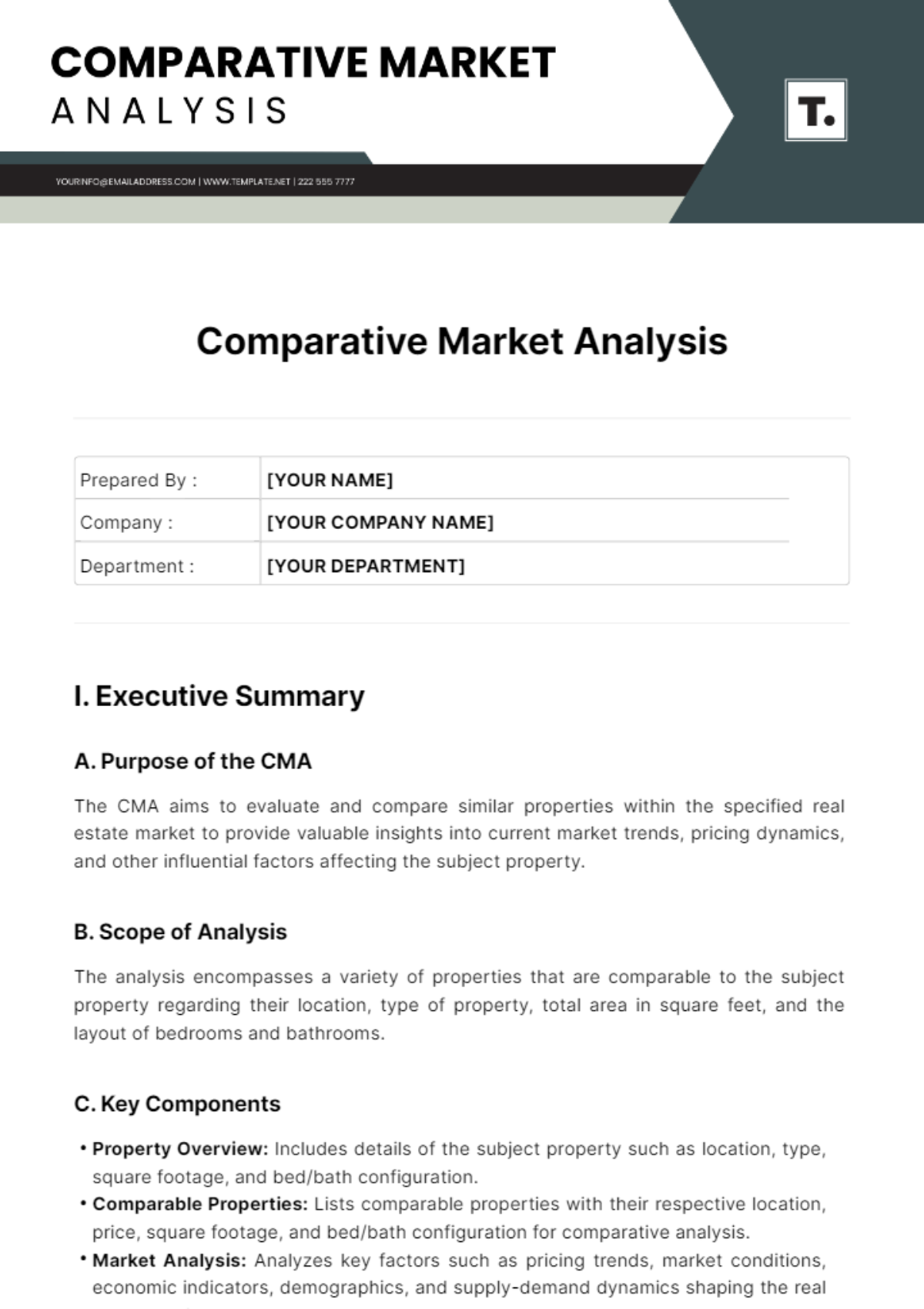Comparative Market Analysis
Prepared By : | [YOUR NAME] |
Company : | [YOUR COMPANY NAME] |
Department : | [YOUR DEPARTMENT] |
I. Executive Summary
A. Purpose of the CMA
The CMA aims to evaluate and compare similar properties within the specified real estate market to provide valuable insights into current market trends, pricing dynamics, and other influential factors affecting the subject property.
B. Scope of Analysis
The analysis encompasses a variety of properties that are comparable to the subject property regarding their location, type of property, total area in square feet, and the layout of bedrooms and bathrooms.
C. Key Components
Property Overview: Includes details of the subject property such as location, type, square footage, and bed/bath configuration.
Comparable Properties: Lists comparable properties with their respective location, price, square footage, and bed/bath configuration for comparative analysis.
Market Analysis: Analyzes key factors such as pricing trends, market conditions, economic indicators, demographics, and supply-demand dynamics shaping the real estate market.
Recommendations: Provide strategic advice on optimal pricing, marketing strategies, and market timing based on analysis results.
D. Importance of CMA
The Comparative Market Analysis (CMA) functions as a vital instrument for making informed decisions concerning the acquisition, disposition, or retention of real estate investments. It provides stakeholders with crucial insights into prevailing market trends, thereby facilitating the formulation of strategic decisions that are in harmony with their objectives.
II. Property Overview
A. Subject Property
Location | [Location] |
Neighborhood Description | Situated in a family-friendly neighborhood with easy access to schools and shopping centers. |
Type | Single-family home with a detached garage. |
Square Footage | Total interior space of 2,000 square feet with an additional 500 square feet of outdoor patio space. |
Bed/Bath | 3 Bedrooms, 2.5 Bathrooms |
Special Features | Includes a spacious master suite with a walk-in closet and en-suite bathroom. |
B. Comparable Properties
Property | Location | Price | Sq Footage | Bed/Bath |
|---|
Comparable 1 | [Location] | $350,000 | 1,800 sq ft | 4 Bed/2 Bath |
Comparable 2 | [Location] | $375,000 | 2,100 sq ft | 3 Bed/3 Bath |
Comparable 3 | [Location] | $320,000 | 1,950 sq ft | 3 Bed/2 Bath |
III. Market Analysis
A. Pricing Trends
Analysis of pricing trends considering recent sales transactions, current listings, and market forecasts. Key insights include the following:
Metric | Value |
|---|
Average price per square foot | $250 |
List-to-sale price ratio | 98% |
Days on Market (Average) | 30 days |
In this analysis:
The average price per square foot reflects the typical price per square foot of properties in the market, indicating the value of space.
List-to-sale price ratio of 98% suggests that properties are selling very close to their listed prices, indicating a balanced market.
Days on Market (Average) of 30 days indicates the average time it takes for properties to sell, providing insight into market activity and demand.
B. Market Conditions
Economic Indicators
Strong GDP growth of 3.5% annually over the past 3 years, indicating a robust local economy.
The low unemployment rate of 4.2%, contributes to stable income levels and consumer confidence in the housing market.
Favorable interest rates averaging 3.5% for 30-year fixed-rate mortgages, incentivizing homebuyers and investors.
Demographic Trends
Population growth of 2% annually, driven by young professionals and families relocating for job opportunities.
Increasing diversity with a growing number of multicultural households influences housing preferences and market demand.
The aging population trend leading to a rise in demand for senior-friendly housing options and amenities.
Supply and Demand Metrics
Low housing inventory with a 10% decrease in available listings compared to last year, leading to competitive pricing and multiple offers on properties.
High demand for starter homes in the market due to first-time buyers entering the market and favorable lending conditions.
The luxury segment experiencing slower sales due to a limited buyer pool and cautious spending among high-net-worth individuals.
IV. Conclusion
In conclusion, the Comparative Market Analysis (CMA) is a vital tool for grasping real estate market dynamics and guiding property transactions in [Location], providing deep insights through evaluations of the subject property, comparables, trends, and economic indicators. Key takeaways include:
Market Insights: The analysis reveals a balanced market with properties selling close to their listed prices, indicating stability and confidence among buyers and sellers.
Pricing Dynamics: The average price per square foot and list-to-sale price ratio provide benchmarks for determining the fair market value of the subject property and setting competitive listing prices.
Market Conditions: Strong economic indicators, favorable interest rates, population growth, and supply-demand dynamics highlight a robust and competitive real estate environment.
Recommendations: Tailored recommendations emphasize strategic pricing, marketing tactics, and timing considerations to optimize outcomes for property transactions.
V. Recommendations
Strategic recommendations based on the CMA findings are tailored to specific goals such as buying, selling, or holding real estate investments. Key recommendations include:
Optimal list price strategy: Based on the comparative analysis, recommend listing the subject property at a competitive price range of $X to $Y per square foot to attract potential buyers while ensuring fair market value.
Marketing and positioning tactics:
Utilize professional photography and virtual tours to showcase the property's unique features, emphasizing the spacious layout, modern amenities, and desirable location.
Implement targeted digital marketing campaigns on popular real estate platforms and social media channels to reach a wider audience of potential buyers.
Highlight the property's value proposition, such as the master suite with en-suite bathroom, outdoor patio space, and proximity to schools and shopping centers, in marketing materials and listings.
Timing for market entry or exit:
Given current market conditions with low inventory and high demand, recommend entering the market within the next 30 days to capitalize on buyer interest and competitive pricing.
Monitor market trends closely to identify optimal selling windows for maximizing return on investment, considering seasonal fluctuations and economic indicators.
VI. Appendices
A. Data Sources
MLS Data: Used MLS data to collect details on recent property sales, listings, and market trends, extracting information like property features, sale prices, and days on the market for analysis.
Public Records: Reviewed public records such as property taxes, deeds, and legal documents to confirm ownership, transaction history, and property details. Used public data to enhance the accuracy and completeness of property information for comparison.
Recent Market Studies: Analyzed recent market data and leveraged insights from reputable sources to enhance the CMA and provide context on real estate trends and conditions.
B. Analyst Notes
Data Collection Process: Detailed notes on the methodology used for data collection, including data sources, data cleaning processes, and data validation techniques to ensure accuracy and reliability of analysis.
Comparative Analysis Method: Notes on the criteria used for selecting comparable properties, including considerations such as location, property type, square footage, bed/bath configurations, and recent sales activity.
Key Observations: Analyst insights on key market trends, pricing, supply-demand, and value influencers, along with unique challenges and opportunities found in the target market analysis.
Analysis Templates @ Template.net






























